#ww1 german submarines
Text

The crew of a German UC-1 class submarine on deck. Introduced in 1915, the submarines of this class were employed mainly on minelaying duties and carried up to twelve mines. German submarines sank 1,845,000 tons of Allied and neutral shipping between February and April 1917
#germany#ww1#ww1 germany#u boat#ww1 german submarines#UC-1 u-boat#kaiserlichemarine#imperial german navy
26 notes
·
View notes
Text

German Submarine Crew during the first world war.
#history#ww1#world war 1#germany#german empire#historical photos#german army#submarine#navy#german navy#wwi#world war i#world war one#photography
61 notes
·
View notes
Video
U-Boat 110, Electric Control Room by Tyne & Wear Archives & Museums
Via Flickr:
This photograph shows the U-Boat 110, a German Submarine that was sunk and risen in 1918. This photograph shows the Submarine's Electric Control Room, including its switch gear. Reference: DS.SWH/5/3/2/14/1/58 This image is taken from an album of photographs found in the Swan Hunter shipbuilders collection at Tyne & Wear Archives. The album is from 1918 and documents the U.B. 110 before she was scrapped on the dry docks of Swan Hunter Wigham Richardson Ltd, Wallsend. The twin-screw German submarine U.B. 110 was built by Blohm & Voss, Hamburg. On the 19th July 1918, when attacking a convoy of merchant ships near Hartlepool, she herself was attacked by H.M. Motor-Launch No. 263 and suffered from depth charges. Coming to the surface she was rammed by H.M.S. Garry, a torpedo boat destroyer, and sunk. In September she was salvaged and placed in the admiralty dock off Jarrow slake. She was then berthed at Swan Hunter's dry docks department with an order to restore her as a fighting unit. The Armistice on 11th November 1918 caused work on her to be stopped. She was towed on the 19th December 1918 from Wallsend to the Northumberland Dock at Howdon and was subsequently sold as scrap. The album of photographs, taken by Frank & Sons of South Shields, documents the U.B. 110 in extensive detail. The photographs provide a rare glimpse into the mechanics and atmosphere of the raised German submarine. More images of the U-Boat 110 can be viewed here. (Copyright) We're happy for you to share these digital images within the spirit of The Commons. Please cite 'Tyne & Wear Archives & Museums' when reusing. Certain restrictions on high quality reproductions and commercial use of the original physical version apply though; if you're unsure please email [email protected]
#submarine#U-boat#German#First World War#steampunk#wheels#German Submarine#WW1#wartime#1918#military#Naval history#shipbuilding heritage#industry#industrial heritage#maritime heritage#archives#records#documentation#Electric Control Room#The sinking and raising of U-Boat 110#U-Boat 110#switch gear#components#Reference: DS.SWH/5/3/2/14/1/58#Tyne & Wear Archives & Museums#digital image#documentary photograph#black and white photograph#Swan Hunter shipbuilders collection
1 note
·
View note
Text



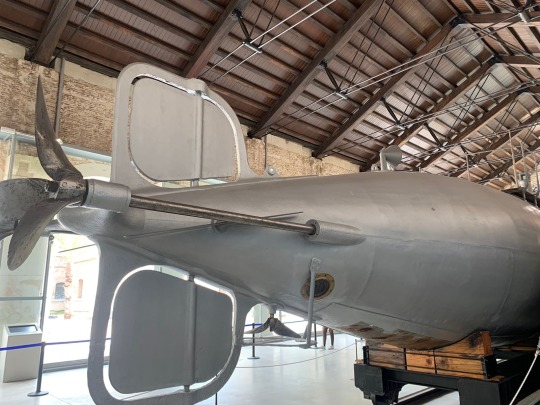
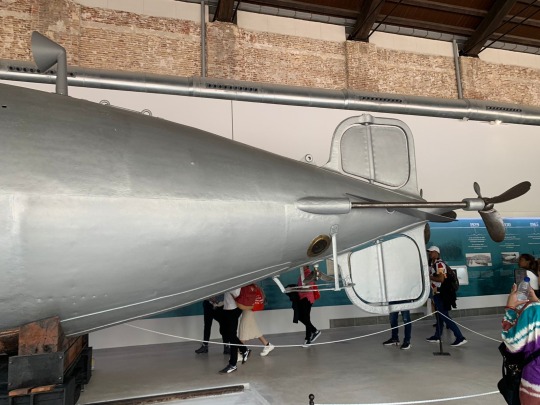




Spanish Submarine Peral
The world’s first modern submarine, equipped with an electric engine, batteries and a single torpedo tube for two on-board torpedoes, the fastest submarine design until the advent of German U-Boats during WW1.
Designed by the Spanish engineer Isaac Peral y Caballero, and built in the city of Cartagena in 1888, it’s now preserved at the Cartagena Naval Museum.
Pictures courtesy of my sister.
81 notes
·
View notes
Note
You asked me a bit ago about my naval plans in my WIP, and the truth is I don't have much, so can I ask for your help in creating some? What sort of shenanigans could a semi-modern navy (think cruisers, battleships, a very few capital class battleships, submarines) get into with officially neutral ports, trade ships, and passenger ships?
I'm thinking most of the naval stuff will involve not the warring major nations, but them fighting over supplies and shipments from other nations. Help me friend!
Well, well, well! Now that is quite the conundrum you've got there, and certainly filled with opportunities for some very interesting scenarios. I'm going to search in my head for some IRL examples of interesting non-total-war uses of naval power in the period, and you can tell me if anything helps!
Here, I've compiled a short list of some interesting naval-related incidents in world history, mostly from the approximate era relevant to Mortal Sparks. I hope they might give some inspiration!
The Tangiers and Agadir Crises: Sea Power, Short Of War
These two incidents, taking place in 1905 and 1911 respectively, were among the defining incidents in European great power politics in the lead up to WW1, and are sometimes touted as possible alternative inciting incidents for what would become the Great War. Both principally concerned the political status of Morocco, but would become stages on which France and Germany would test the influence of themselves and their respective alliances against one another. The naval aspect of the affair was most obviously shown in the second crisis, which saw a German gunboat dispatched to Morocco as a sign of their willingness to back their position with force, soon followed by the gunboat's replacement with a cruiser.
While France, Germany, and the UK would end both crises at the negotiating table, Germany's Kaiser Wilhelm II in particular would feel particularly slighted at having come out on the losing end twice. Meanwhile, France and the UK would solidify their burgeoning entente with the signing of further naval treaties specifying either ally's role in the event of a full war with Germany.
South American Naval Arms Race: Ships For Sale?
This is less an example of great powers competing through the naval domain, and more an example of the shenanigans that great naval powers can be involved in even if they themselves have no intention of firing a shot in anger. Taking the form of a three way competition between Brazil, Chile, and Argentina from the late 19th century and into the 20th, it would see these countries massively expanding their respective navies. However, as none of the three regional powers possessed the industry and infrastructure to construct modern warships themselves, their fleets would be made up of dozens of ships built and designed by foreign, predominantly British, shipyards. The whole crisis would be considerably exacerbated by the creation of HMS Dreadnought, which single handedly rendered all existing battleships practically obsolete and spurred on demand for existing capital ships to be replaced rapidly across the board. In fact, Brazil's own exceptionally ambitious reaction to the affair would lead to it acquiring its own first dreadnoughts, of the Minas Geraes class, before Germany, France, Russia, or Japan would, built by the British companies Armstrong and Vickers, and in many ways superior to the first existing British and American dreadnoughts.
It's also notable that, despite the UK's own yards supplying the ships that manifested this crisis, the British government would repeatedly attempt to defuse tensions in order to preserve its valuable trade relations with the region. Interestingly enough, when WW1 did break out, many of these ordered dreadnoughts would still be under construction in their British yards, and either by seizure or purchase be acquired by the Royal Navy, alongside, interestingly enough, battleships under order for the Ottoman Empire.
Anglo-German Ocean Liner Race: Battles With Bling
An edge example, but I thought it'd be an interesting one since you did mention passenger ships! While the Anglo-German Naval Arms Race gets a lot of attention with its contributions to WW1, a similar competition in the sphere of commercial success and national prestige was playing out between the shipping lines and yards of the two great powers of the early 20th century. Size and luxury substituted firepower and protection when it came to key design features, but speed was of equal importance to both. If I were to make a larger point with this example, it would be that states which can raise and support large navies with the relevant infrastructure, technology, and skilled labour often have sizeable civilian maritime sectors as well. The usage of ocean liners as troop transports, on the other hand, shows how civilian assets in peacetime can be mustered for wartime service.
Beware, Arch deserts from his commitment to sticking to a specific era in the content below. Read at your own risk.
The Altmark Incident: Neutrality Not Withstanding
A touch past the scope of the designated era, and close to being an 'actual' war scenario of the sort I'm supposed to be avoiding, but it's honestly such a fascinating incident that I couldn't not include it. The crisis takes place during the so-called 'Phoney War', a period usually defined as spanning between invasions of Poland and of France and the Low Countries. A crucial point in the events of the crisis, and what ultimately made me decide to include it in this list, was the fact that Norway itself was still a neutral nation at this point, with ties to both Germany and the Western Allies.
The inciting event of the whole incident surrounds the German auxiliary vessel Altmark. Sailing back to Germany from the Atlantic down the coast of Norway, she carried three hundred POWs taken from British shipping by the 'pocket battleship' Graf Spee on her convoy raids. After the latter's destruction, she'd fled British and French naval forces, and at this stage relied on the neutrality of Norway and its territorial waters to safeguard herself and her cargo. A series of events I lack the ability to summarise would occur between the auxiliary and Norwegian authorities, which resulted in Altmark being allowed passage through a specially protected zone of Norwegian waters around Bergen to avoid an international incident.
The British government, finding about the matter via its embassy in Oslo, had other ideas. A force consisting of a light cruiser and five destroyers was immediately dispatched to intercept Altmark. The flotilla would make contact with the auxiliary while she was still under neutral Norwegian escort. The British would make increasingly brazen attempts to isolate Altmark as the collection of ships approached Germany, and when she finally ran out of space to manouevre the German vessel entered a fjord and ran aground on its ice, trapped. The British commander on the scene requested that their POWs be released, his Norwegian counterpart stated that he would refuse any British boarding attempt with force if he had to, and after seeking permission from the Admiralty HMS Cossack stormed into the fjord and, just avoiding a last ditch ramming attempt by the Altmark, boarded the auxiliary and freed the prisoners.
The sheer political fallout from the whole affair was immense. Norway, of course, protested the brazen breach of neutrality that had just taken place, while the UK criticised Norway for allowing a ship carrying POWs to pass through its waters. The applicability of any of these events to your worldbuilding is something I can't predict, but at least it might give you an example of the shit storms that can come about even with neutral states.
The S-363 Incident: Whiskey On The Rocks
If you thought the last example was a strange one, you ain't seen nothing yet! This affair, often referred to as the "Whisky On The Rocks" Incident, is probably one of the most personally fascinating Cold War events I can think of, and with some slight tweaking could fit in with any time period.
The incident centers on the Soviet diesel electric submarine S-363, of a type referred to under NATO terminology as the 'Whiskey' class. Whilst conducting a surveillance mission on a major Swedish naval exercise, the submarine ran aground in Swedish territorial waters. An unarmed Swedish officer was sent to board the boat and question her captain, who blamed serious failures in navigational equipment as reasons why his submarine had traversed numerous fjords and islands to come aground so close to the major Swedish naval base of Karlskrona.
The Soviet captain was removed from the boat for interrogation in the presence of Soviet officials, while Swedish authorities searched the submarine. In the meantime, a sizeable Soviet naval task force was assembled and put to sea in the Baltic, approaching Swedish waters. Using radiological equipment, traces of uranium were found in the boat's torpedo tubes, suggesting the presence of nuclear torpedoes aboard S-363.
A storm swept over the region, leading the grounded submarine to send out a distress signal. Soon afterwards, two unknown vessels were detected entering Sweden's territorial waters from the last known point of the Soviet flotilla, heading straight towards Karlskrona, and the crisis reached its height of tension. Swedish aircraft were armed and ready to strike, and coastal batteries were put on full alert. Finally, it would be revealed that the two vessels were actually a pair of German merchant ships.
The crisis would end ten days later with the return of the submarine to Soviet authorities, but marks one of the most tense periods of the Cold War, a 'conflict' which on the whole saw little open fighting between the major powers involved in it.
#writeblr#worldbuilding#writeblr stuff#guess which eras of history I'm most familiar with!#the answer will not surprise you#sorry but I hope you can find some of this useful in your Worldbuilding!#on the one hand it feels like I'm not doing much beyond summarising some interesting bits of naval history#but at the same time learning about these events is how I've developed my 'instincts' when it comes to creating events in the 12 Worlds#if you'd like more help developing something yourself I'd be happy to help!
6 notes
·
View notes
Note
Is there a way Germany could have won WW1?
Very much so. It was very much a back-and-forth that could have gone many different ways for Germany, either early on, or even later. There are plenty of feasible paths to a Central Power victory, unlike WW2.
If the Germans had avoided Belgium, or perhaps flanked the French at the Marne. If the disastrous Chemin des Dames attack had caused an uprising against the French Republic instead of just the French officer corps. If the Americans maintained neutrality by not having submarine warfare. If the Germans had settled for a lighter peace at Brest-Litovsk and gotten its Eastern front troops to the west earlier. And so on, and so forth.
Thanks for the question, Anon.
SomethingLikeALawyer, Hand of the King
14 notes
·
View notes
Text

Control room of a WW1 German submarine UB-110.
This image shows manhole to periscope wall, valve wheels for flooding and blowing. Hanwheels for periscope gear, air pressure gauges. The UB-110 sunk after attacking a merchant shipping convoy near Hartlepool in July 1918. It was then salvaged and transferred to Swan Hunter Wigham Richardson Ltd. Dry Docks (Wallsend), with an order to restore her to fighting state. The order cancelled following Armistice and she was scrapped thereafter.
13 notes
·
View notes
Note
random historical trivia
the titanic was part of a line of Olympic class ships, which 3 were made. (2 sunk, titanic and britannic, who was sunk by a mine during ww1 after being converted into a medical ship)
but the one that i want to mention is the olympic, who was turned into a troop transport in ww1 and did something incredible
"During the First World War, the ship served as a troop transport. On 12 May 1918, she rammed and sank the German submarine U-103. "
also sad fact about the olympic, it was sailing in the atlantic at the time of her sister ship, the titanic, sinking. it heard the distress signal but was too far away to help
that would be an Insane family-comparison to live through. "your sister sunk a german submarine in the first world war and what are You doing!!!" ramming and losing to an ice cube six years earlier, amen.
oh shit Olympic had a special paintjob now That's pretty. fuckin hell, troop transport... so many people in there
7 notes
·
View notes
Text

10th October 1918 - Ireland. The Sinking of the RMS Leinster.
Shortly before 9 a.m. the R.M.S Leinster left Carlisle Pier, Kingstown bound for Holyhead. On board were 771 passengers and crew. In command was Captain William Birch, a 61 year old Dubliner who had settled with his family in Holyhead. The Leinster had a crew of 77. Also on board were 22 postal sorters from Dublin Post Office, working in the ship's onboard postal sorting room. There were 180 civilian passengers and 491 military personnel, many of them going on, or returning from, leave. The passengers came from Ireland, Britain, Canada, the United States, New Zealand and Australia.
An hour into the voyage and about 16 miles from Kingstown, people on deck spotted a torpedo track in the water. The torpedo, fired by a German submarine, UB-123, missed the ship, and passed in front of the bow. Minutes later a second torpedo hit the Leinster on the port side where the postal sorting room was located. All but one sorter died in the blast or drowned in the flooding sorting room. The survivor was named John Higgins who survived by clinging on to electrical cables while allowing the rising water carry him up to a trapdoor in the ceiling.
Meanwhile the ship turned through 180 degrees in an attempt to return to port while at the same time beginning to launch the lifeboats. At this point a third torpedo hit her in the starboard side and the Leinster sank a few minutes later. Officially 501 people died in the sinking, but modern research sets the figure between 529 and 564 casualties.
The sinking of the RMS Leinster led to the greatest ever loss of life in the Irish Sea. Amongst the casualties were Captain Birch and 36 of his crew. Two of the Leinster's three Royal Navy gunners died. 115 civilians lost their lives, including almost all of the members of the Gould family from Limerick. May Gould was travelling with her five children to join her husband, who was working in a munitions factory in England. One daughter survived the tragedy. Amongst the military casualties was 19 year old Clerk, Josephine Carr from Cork, who became the first member of the Women's Royal Naval Service to die on active service. Her body was not recovered and she is commemorated on the Plymouth Naval Memorial.
UB-123, commanded by Oberleutnant Robert Ramm, hit a mine in the North Sea on 18 October while returning to Germany. She sank with the loss of the entire crew of 35 men.
The members of the Royal Irish Regiment commemorated on this date in 1918, all died in the sinking. Another connection to the Royal Irish Regiment was one of the civilian casualties, Fanny Wookey. Her son, Second Lieutenant Frederick Maurice Wookey, died of wounds in France on 19th March 1915, while serving with the Regiment. Her husband had died in July and Mrs Wookey, having sold the business and the family home, was planning to live in England.
#18thfoot #royalirishregiment #greatwar #worldwar1 #ww1
https://kildarecoco.ie/library/LocalStudiesGenealogyandArchives/DecadeofCommemorations/WorldWarI/Remembrance%20WWI%20Book%20June%202021.pdf
5 notes
·
View notes
Photo
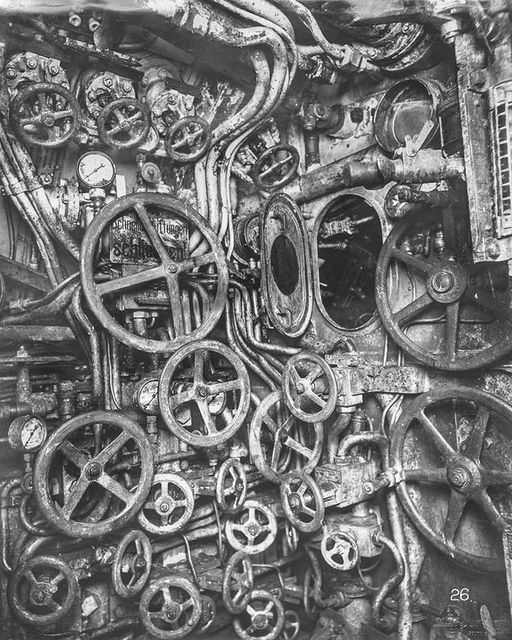
Control room of a WW1 German submarine UB-110.
This image shows manhole to periscope wall, valve wheels for flooding and blowing. Hanwheels for periscope gear, air pressure gauges. The UB-110 sunk after attacking a merchant shipping convoy near Hartlepool in July 1918. It was then salvaged and transferred to Swan Hunter Wigham Richardson Ltd. Dry Docks (Wallsend), with an order to restore her to fighting state. The order cancelled following Armistice and she was scrapped thereafter.
10 notes
·
View notes
Text
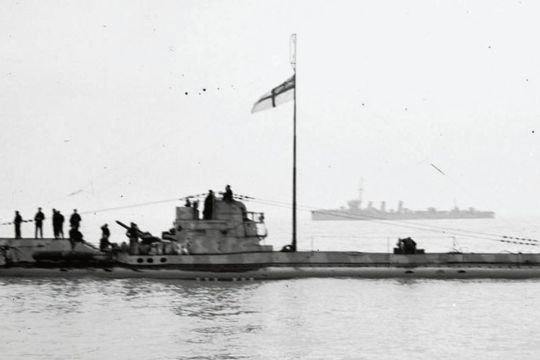
Kaiserlichemarine (Imperial German Navy) U-boat, the UC 31, location and date unknown
10 notes
·
View notes
Text
TDSP WEEKEND UPDATE

What is Attrition Warfare?
It is the strategy of war where the result is to grind down the enemy to the point of surrender instead of winning territory on the battlefield. A good example is WW1. Nothing has been gained except mass casualties.
Now what the fuck does WW1 have to do with our Distant Shores sequel?
As mentioned in a previous blog, we have some history buffs on the crew, and we thought the techniques used will be a great inspiration for the battles between our beloved DS crew and The New Admiral. Just like his brother, The New Admiral is a powerful and evil man. The vengeance he has against the DS crew for what they did to his brother is nothing to be trifled with. He seeks no territory to be gained, only to bring his enemies to their knees. That includes his enemies’ people back home will pay the price as well. Tiburon was always thankful for what Ed and his crew have done for them. It’s only justified in The New Admiral’s mind that they will need to be impacted as well. It’s as if he went forward in time and borrowed the strategies from the British and Germans during WW1. Now how to go about attaining those so called U-Boats...
During WW1, Attrition Warfare also meant that citizens would be impacted too. The British issued a naval blockade against the Germans, so they couldn’t get imports such as food. Their goal was to starve Germany into surrender. The Germans counterattacked by sinking any ship that came into contact with them with their submarines, believing they were all carrying supplies to help aid Great Britain and her allies. That means civilians will not only be killed at sea (we’re looking at you, Lusitania), but Germany’s enemies will be dealing with mass shortages back home.
We already have been getting questions regarding people wanting to start their own ID sequel, and how to go about doing it. We will be putting up a blog post later in the week about how we do things.
10 notes
·
View notes
Photo

In 1918 the Swan Hunter Wigham Richardson Ltd shipbuilders in Wallsend, England, scrapped a U.B. 110 German submarine. The twin-screw U.B. 110 was built by Blohm & Voss, Hamburg. This image shows manhole to periscope wall, valve wheels for flooding and blowing. Hanwheels for periscope gear, air pressure gauges. The UB-110 sunk after attacking a merchant shipping convoy near Hartlepool in July 1918. .. More pictures on our story: Extraordinary Photographs of a Captured WW1 U-Boat Submarine (1918). #war #technology #tech #design #ww1 #england #germany #machine #engineering #submarine #submariner #history https://www.instagram.com/p/CotwshLsSTj/?igshid=NGJjMDIxMWI=
2 notes
·
View notes
Text
5 worst policy decisions in history
German over engineering- Germans had only artillery better than French and they still won the war (owing to French not using machine guns properly and not being proficient in military tactics). This led to an obsession with perfectionism in German engineering. Where in ww2, they had crafted magnificent submarines which were pieces of art to say the least but these were detected by simple SONAR technology and busted. More technology also creates more points of failure. Ex - A submarine has about 8,000 to 10,000 screws.
Iran's habit of taking hostages - 1200 Started with taking Mongol hostage. It took 600 years to revive persian population to pre 1200 levels. 1800 Russian ambassador taken hostage, russia invades, annexes Chechnya and Azerbaijan. Us was looking for diplomatic solutions but again a hostage was killed which then led no space for negotiations and Iran Iraq war took place.
Successful Socialism- Sweden, Finland made war profits during WW1 and WW2. Nordic countries have very high outward migration rates. Anyone who wants to overperform leaves. Norway became rich due to oil in North Sea. Citizens pay 50%-60% taxes. Many Swedish companies are based out of Sweden due to this. Denmark made enormous profits in pork sales during World War.(These countries which are the epitome of socialism have population less than South delhi). The Fins used western technology to develop ships and sold them over to USSR.
Mercanitilism(Colonisation) - The North Italy used to be poor and the South Italy used to be rich due to surplus agricultural production. The North however became the ruling class later due to the surplus of South pouring into their colonised North. This later led to the North becoming today's rich Italy. 1990s North Belgium - Flemish. South Belgium - French Speaking. Coal, steel factories were located in South. The northerners were employed as workers and the South didn't invest in the north to develop. In 2000s, however the North adopts the Information Revolution and became the richer part. Northern Belgians went from being considered barbarians to posh. Mercantilism isn't a sustainable model. Britain ended up subsiding India after 1911.
Decision of NATO to expand East-Russia has been pushed into Chinese influence(Earlier putin was always suspicious of China). India (the 3rd biggest power in Eurasia) will be at the highest danger when 2 biggest powers come together.
0 notes
Text
Steven F Uzdar-Hazy Air and Space Museum - Chantilly, VA
Visit: Tuesday December 13th 11am-2pm 2022
Louie and I spent our last morning with Charlie at the Air & Space Museum near the Dulles Airport. Parking cost less than $10 (Louie can't remember exactly), but they did only have credit options open that day (no ticket stall was open that would take cash). There was tons of parking available in the lot, and this museum isn't close to much else so parking directly here seems like the only option.
The museum layout is HUGE. With multiple levels, exhibits, an imax theater, an observation tower, and an engineering warehouse, it would take several multi-hour visits to thoroughly explore and experience the entire museum. I always expect air & space museums to be gigantic, but this may be the biggest I've ever visited. Pictured is a map of one of the floor layouts:
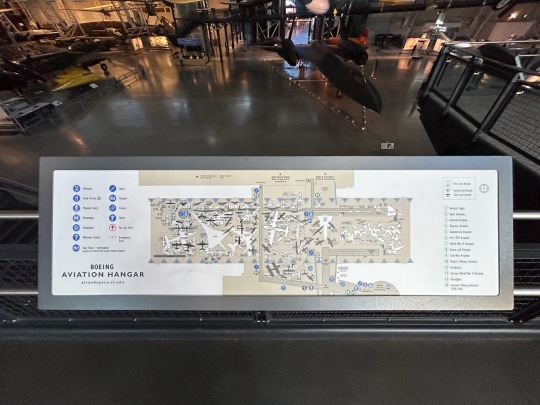
Visitors walk into the museum through a huge exterior colonnade, into the grand opening glass doors of the museum that let so much natural light in. Visitors then pass through several metal detectors and under the scrutiny of at least 5 different security personnel (on this given day at least). Beyond this point you have free access to the museum, and there are donation stands and an information center right at the front.
I liked that the first hallway has exhibits on Uzdar-Hazy, how he began the museum and his own motives (childhood obsessions with flight) that led the museum to exist today. The context of origin was neat as we got to inspect little model planes that U-H had made as a boy out of matchsticks, pencils, gum and nail polish (I forgot to take a picture)
The museum has special exhibits on planes from WW2 - with large dedicated panels of information to the Allies airforce in WW2, the beginning of flight in the US (with many early planes), and German planes from the Luftwaffe (Germany's WW2 airforce), and examples of Japanese planes as well. More recent planes that have been "retired" are shown in the museum, many being the only remaining plane existing of that particular model.
All aircraft have plaques identifying the make & model, specs and paragraph-long bits of history/interest about that particular make.
Here are some examples of planes I saw:

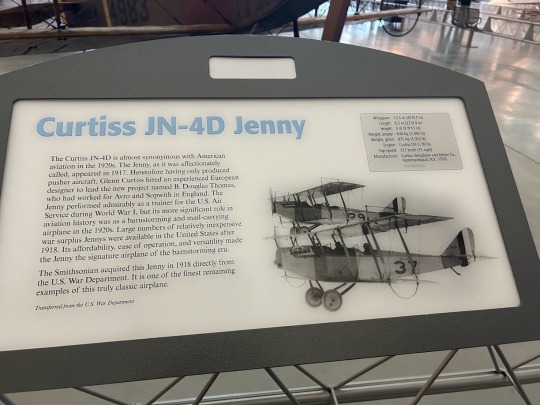
The Jenny is one of my favorites - to me it symbolizes a time in aviation when the point of flight was frivolous and playful. Humans were taking to the air to see what they were capable of, hosting air shows and rides, with no purpose but to astound and inspire.
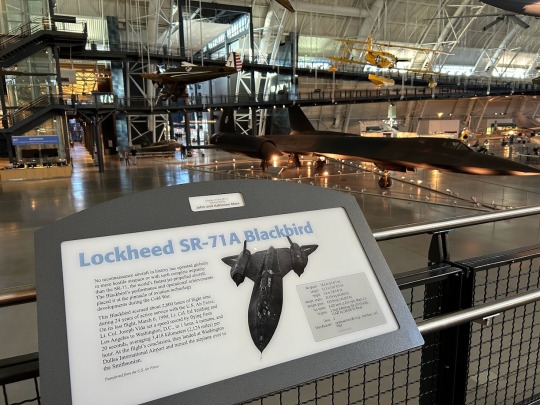

In contrast the Blackbird was developed as a stealth plane, for recon during a time when the tensions of the Cold War were at their peak - after a long history of aircraft being used for war & power. Still though, Louie (who brings a background enthusiasm for aircraft) told me a story of the Blackbird operators and how they would tease other, significantly slower aircraft.



These were larger panels of information highlighting certain sections of the museum. I asked a docent if there were options for translations of info at the front desk, but he said that since the pandemic they haven't figured out a way to offer language alternatives (He described them using a headset prior to the pandemic). In this way the information presented definitely seemed to assume the demographic of its audience. Notably as well the 3 volunteer docents that we interacted with were all white men past retirement.
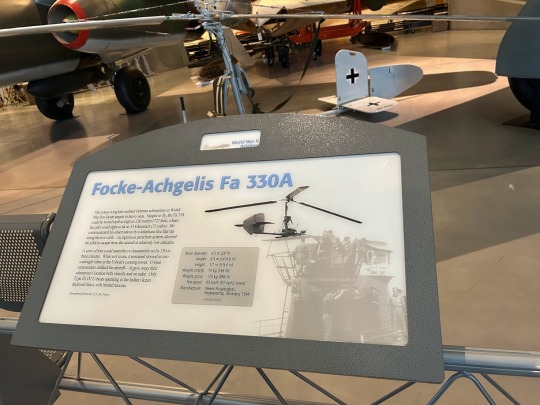

This FA 330 was used as a "kite" by German submarines to locate targets. Other craft built more simply like this were used for research purposes, but I failed to get photos of those.

KittyHawk
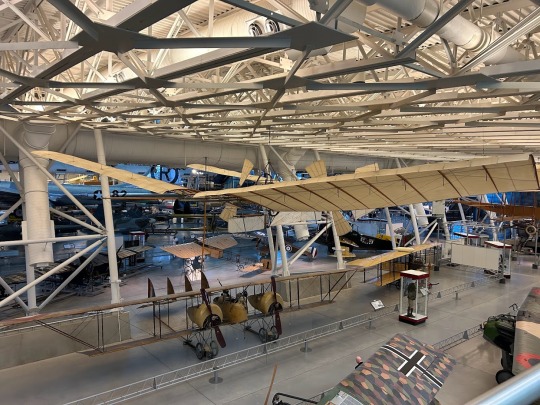

Craft from early aviation
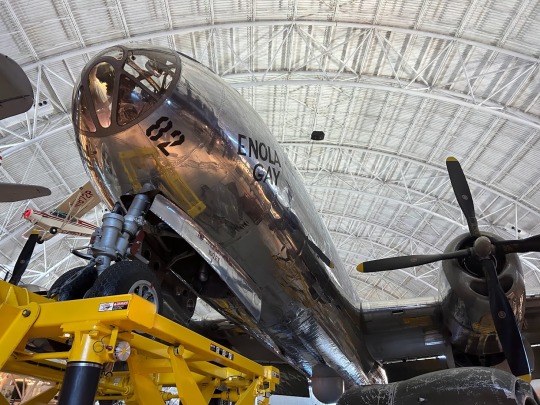

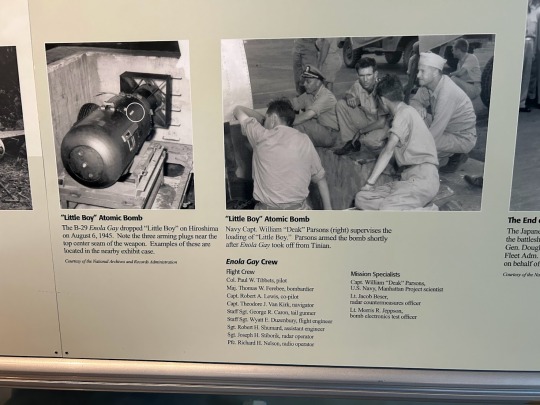
The Enola Gay gave me goosebumps, thinking about that time in history when it felt appropriate to some to destroy a nation, the consequences of which it still recovers from today. Is there any ideal worth fighting for to that level of destruction?
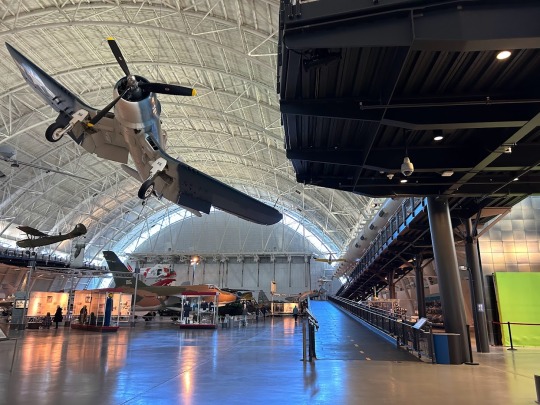
The underbelly of a Corsair
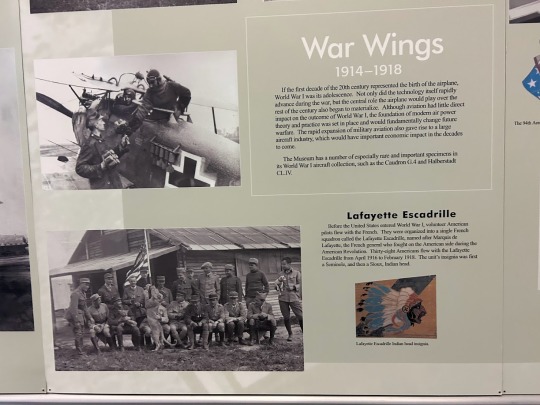
I was curious about the use of a Sioux figurehead on the French WW1 escadrille. What was the intended symbolism here, and what are the unintended consequences of a legacy of naming war planes after our indigenous tribes while simultaneously hunting them, jailing them, demonizing them, and taking their children from them?

I just thought this wheel design was fascinating & brilliant!

In the museum there are also cases and cases of artifact displays. i didn't get photos of much but they highlights supplies, entertainment, weapons, and uniforms.
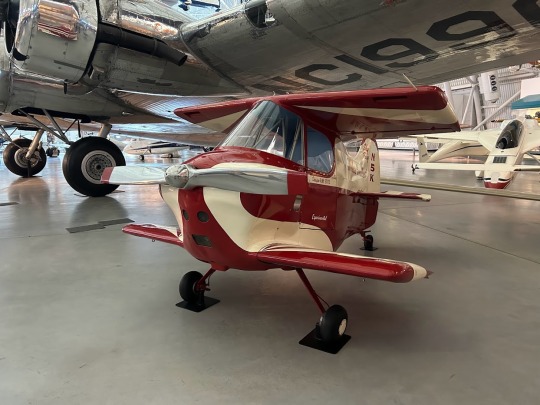
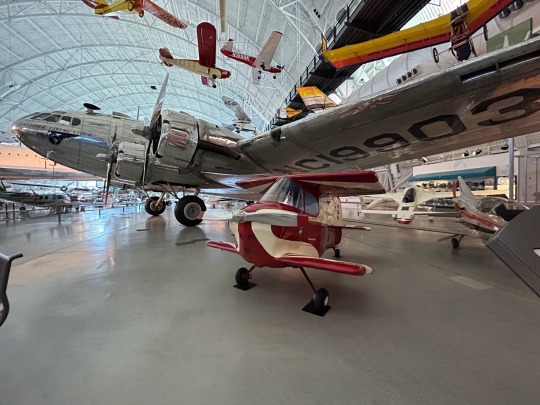

There were also aircraft there that were yet more frivolous - this SKyBaby being one of the smallest aircraft to ever be built!
Next in the museum was the Space exhibit, but we zoomed through that as we were running out of time and I wanted to see the observation tower. Here are a couple things I saw, but didn't look into:


I wish I'd caught the name of this spacecraft, it was stunning and reminds me of a boss you'd have to fight in a video game.
Finding the right route to the observation tower was a bit tricky, the floors are huge and there are only a few floor plans sprinkled about. We walked past a special exhibit of hot air balloons and their influence on culture, art and society. We also stopped to observe planes being restored/built in the engineering warehouse - visitors had a birds-eye view of what projects were taking place on the floor (no direct access though), it was a really profound way to see and appreciate the restorative work that occurs here at the museum. Felt behind-the-scenes without being intrusive or needing a guide.
There is a shake-shack restaurant inside the museum so we all stopped for a shake, the museum store right next to it (we've circled back close to the entrance/exit again). The Shake Shack guy says he doesn't know if food is allowed in the store, but he has seen folks try to take food into the museum and the security guards have forced people to throw out their food "they don't tell you to turn around - they tell you to get rid of it." I thought that was interesting and possible dramatic, but who knows? There were plenty of signs though, and one at the museum shop entrance saying that no food or drink was allowed inside the store. No problem! The area inside the restaurant had plenty of seating, wonderful warehouse-length windows with natural light to view the sky.
The store itself had a huge variety of items to interest its visitors - the demographics targeted would be interested in science-based games, activities for all ages, clothing, books (in english) for all ages, branded souvenirs (like keychains, mugs & shot glasses, magnets, etc...), toys, and big-ticket display memorabilia. The shop was very neat and the items were displayed together according to theme or type.
We then finally made it to the observation tower elevator, where a friendly docent instructed us to take the elevator to the top level, enjoy the view and to look for planes landing at the Dulles airport. We were admonished not distract the pilots by waving at them, and to report back if we were lucky enough to see any land. :)



There were two docents in the tower when we went - seeming to change guard. Neither of them interacted with us - I felt a bit more "watched" than approachable. In hindsight I should have interacted to see what information they did have and how they would interpret the otherwise incredibly bare observation tower. We saw several planes land at the Dulles air strip nearby to the North. The only signage in the tower was this directional "South" panel. It insinuates that there is a display to the right of the panel with stone tool artifacts and more that were discovered on the museum site prior prior to construction. There is no display, and the panel does not mention which Native tribes are associated with the Chantilly area. That is a huge loss and I wish I'd asked more about that while at the museum. A search tells me that around 1600 CE, the area was once part of the Powhatan Chiefdoms - a large nation of 30 united tribes with a governing head that actively lived across the territory at that time. From this information I imagine the archaeological findings from this site would be significant.
The observation tower left a lot to be desired in terms of interactive displays and information, so we left after 5-10 minutes and passed by the old docent, "We saw three planes land!... Well, one of them didn't make it... we waved." He laughed and we left to see the show "To Fly" which was described to be a survey of flight from the beginning to the modern day. I didn't realize until afterward it was filmed 1970. It certainly felt dated - none of us could name any substantial information we'd gained from the experience - we mostly just talked about how dizzying the visuals were - it was meant more to be an esthetic experience than educational.
As we left we were thanked and bid goodbye by the security at the entrance and walked back to the car to take Charlie to the airport. And that was our trip!
Museum Rating
Accessibility: This museum is further out in the boonies of Virginia - one would need reliable transportation to get to-and-from the museum. There is an under $10 parking fee, but payment options are limited, so while the museum is free, you have to pay money to access it. The signage is extensive, but there were no linguistic options, braille, or tangible things to experience. This museum was almost solely visual & literate experience. There are ramps and elevators everywhere, but few sitting spaces or reflection areas in the museum corridors themselves. The store definitely felt targeted toward english-speaking visitors. The museum is open daily from 10am-5:30, which is semi-accessible, but I would truly love to see museums open later to allow a different demographic access to its exhibits.
Service: Friendly staff and volunteers, though I didn't necessarily want to interact with every single person there. Easily over 40 volunteers and staff present, so they were easily accessible.
Depth: I think this museum's highlight is its breadth - panels for each plane were limited to a paragraph or two of information, I could have used more information/stories/connections
Breadth: Yes! While the museum's most visible narrative is the military aspect of flight, it is a huge collection of significant aircraft through time, and one can consider this museum as a survey of the human pursuit of flight. The fact that the engineering warehouse has also been incorporated into the museum's exhibits is exciting and adds a layer of "collection stewardship" to the otherwise "show and tell" exhibits. In addition it broadly tells the overviews of WW1 & WW2, of commercial flight, and of space exploration.
Narrative/Flow: The floors are easy to navigate, with maps accessible near transition points (stairs, ramps, and elevators), and you could begin on the left with early aviation and follow the narrative through a chronological retelling of aviation history, with emphasis on the militaristic uses of aircraft through time.
Interactivity: No points. While it looked like there were activity workshops, and simulation machines, they all needed docents to be run and had set schedules, so without an interpreter or guide those activities are inaccessible. The rest of the museum relies solely on docents, signage, and visual impact.
Relatability: Without the interactive aspect of the museum I related to it only through my original interest in air & space museums. This museum, while interesting, was not relatable. One area of missed opportunity was the observation tower - there could have been more information on the skyline and surrounding area - with identification and even historic overlay - what would the area have looked like in 1600? in 1800? etc... Another missed opportunity was highlighting the history of the land itself - an exhibit with information on the specific original inhabitants and what was found on this museum's site would have been a fascinating way to tie multiple histories together with the visitor. Another missed opportunity is a conversation about the Hiroshima bombing - With the Enola Gay looming I think it would be easy to add into the signage thought-provoking questions about human rights, advanced military warfare, civilian casualties and the responsibility of power.
Website: Easily navigable! The aircraft descriptions are all stored online too :)
Wonder & Awe: In spades. This is an astounding museum - it's humble to stand next to these wondrous pieces of machinery, considering how so many were made before the computer, before the calculator. It's a humbling experience to stand under the Enola Gay, it's weighty legend heavier than the plane itself. This balanced with the light-heartedness of the history of the barnstorming era, when flight was fancy-free and explorative, not necessarily directed and purposeful.
Wild Card Points: None. Overall this museum was impressive, but traditional.
1 note
·
View note
Text
WW1 French Army Wargame Set - Total War 1915 (28mm Resin Miniatures)
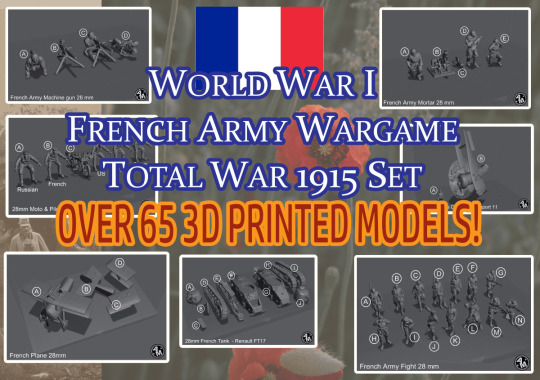
World War 1 French Army Wargame Set - Total War 1915 (28mm 1:64 scale Resin Miniatures)
Era: World War 1
Details: This set includes the following wargame sets: (1) World War 1 French Army Machine Gun Set (quantity of four), (2) World War 1 French Army Mortar Set (quantity of four), (3) World War 1 French Army Wargame Fighting Set (quantity of two), (4) World War 1 French Army Tank (quantity of two), (5) World War 1 French Army Plane Set (quantity of two); (6) World War 1 French Army Motorcycle & Rider Set (quantity of four); and (7) World War 1 French Army Cannons (quantity of 4).
History: World War I, often abbreviated as WWI or WW1, also known as the First World War and contemporaneously known as the Great War and by other names, was an international conflict that began on 28 July 1914 and ended on 11 November 1918. It involved much of Europe, as well as Russia, the United States and Turkey, and was also fought in the Middle East, Africa and parts of Asia. One of the deadliest conflicts in history, an estimated 9 million were killed in combat, while over 5 million civilians died from occupation, bombardment, hunger or disease. The genocides perpetrated by the Ottomans and the 1918 Spanish flu pandemic spread by the movement of combatants during the war caused many millions of additional deaths worldwide.
In 1914, the Great Powers were divided into two opposing alliances: the Triple Entente, consisting of France, Russia, and Britain, and the Triple Alliance, made up of Germany, Austria-Hungary, and Italy. Tensions in the Balkans came to a head on 28 June 1914 following the assassination of Archduke Franz Ferdinand, the Austro-Hungarian heir, by Gavrilo Princip, a Bosnian Serb. Austria-Hungary blamed Serbia and the interlocking alliances involved the Powers in a series of diplomatic exchanges known as the July Crisis. On 28 July, Austria-Hungary declared war on Serbia; Russia came to Serbia's defense and by 4 August, the conflict had expanded to include Germany, France and Britain, along with their respective colonial empires. In November, the Ottoman Empire, Germany and Austria formed the Central Powers, while in April 1915, Italy joined Britain, France, Russia and Serbia as the Allied Powers.
Facing a war on two fronts, German strategy in 1914 was to defeat France, then shift its forces to the East and knock out Russia, commonly known as the Schlieffen Plan. This failed when their advance into France was halted at the Marne; by the end of 1914, the two sides faced each other along the Western Front, a continuous series of trench lines stretching from the Channel to Switzerland that changed little until 1917. By contrast, the Eastern Front was far more fluid, with Austria-Hungary and Russia gaining, then losing large swathes of territory. Other significant theatres included the Middle East, the Alpine Front and the Balkans, bringing Bulgaria, Romania and Greece into the war.
Shortages caused by the Allied naval blockade led Germany to initiate unrestricted submarine warfare in early 1917, bringing the previously neutral United States into the war on 6 April 1917. In Russia, the Bolsheviks seized power in the 1917 October Revolution and made peace in the March 1918 Treaty of Brest-Litovsk, freeing up large numbers of German troops. By transferring these to the Western Front, the German General Staff hoped to win a decisive victory before American reinforcements could impact the war, and launched the March 1918 German spring offensive. Despite initial success, it was soon halted by heavy casualties and ferocious defense; in August, the Allies launched the Hundred Days Offensive and although the German army continued to fight hard, it could no longer halt their advance.
Towards the end of 1918, the Central Powers began to collapse; Bulgaria signed an Armistice on 29 September, followed by the Ottomans on 31 October, then Austria-Hungary on 3 November. Isolated, facing revolution at home and an army on the verge of mutiny, Kaiser Wilhelm abdicated on 9 November and the new German government signed the Armistice of 11 November 1918, bringing the fighting to a close. The 1919 Paris Peace Conference imposed various settlements on the defeated powers, the best known being the Treaty of Versailles. The dissolution of the Russian, German, Ottoman and Austro-Hungarian empires led to numerous uprisings and the creation of independent states, including Poland, Czechoslovakia and Yugoslavia. For reasons that are still debated, failure to manage the instability that resulted from this upheaval during the interwar period ended with the outbreak of World War II in 1939.
Source: https://en.wikipedia.org/wiki/World_War_I
Description: This 3D Printed model represents an historically accurate facsimile at a scale that one can use for diorama making, model train railroad scenery, war gaming terrain, or creative projects.
Quality: Before selling a 3D print, we make a series of test prints at different model scales to ensure quality, and print reliability. In addition, we print each 3D model using the same resin or PLA plastic brand every time for consistent and repeatable results.
Scale: 28mm figure height (1:64 scale)
Type: 3D Printed Models: unpainted 3D Printed models for you to customize and integrate into your wargame tables, model railroad displays or other artistic and creative projects.
License: This licensed 3D Printed Model was designed by Alphonse Marcel, all rights reserved.
Read the full article
1 note
·
View note